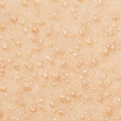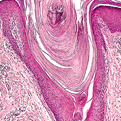Keratosis Pilaris
General Information
Keratosis Pilaris (KP) is a genetic disorder of keratinization of hair follicles of the skin. An extremely common condition that manifests as small, rough folliculocentric keratotic papules, often described as chicken bumps, chicken skin, or goose bumps. It is a result from buildup of protein (keratin) in the openings of the hair follicles in the skin. They are not painful or significantly pruritic in most patients. Clinically diagnosed by appearance and distribution of lesions. No single treatment improves the disorder, but there are some options to soften the keratin deposits in the skin. Using mild cleansers are recommended. Prescription medications include Ammonium latate (cream or lotion), Urea (Carmol, Keralac), Topical corticosteroids and Topical retinoids. The use of medications may lead to positive results however, if treatments are discontinued the condition will return. Although medications will reduce the appearance of the disorder, in some cases symptoms usually remit.
Epidemiology
Affects 50-80% of adolescents and approximately 40% of adults worldwide
Etiology
Not fully known, 50-70 have a genetic predisposition
Pathogenesis
Lack of proper desquamation of keratinocytes, the follicular orifice becomes plugged with keratin and results in a keratotic papule. A variable degree of perifollicular erythema occurs.
Clinical
The skin is described as chicken skin or goose bumps. Often, 10-100 very small slightly rough bumps are scattered in an area.
Histology
Mild hyperkeratosis, hypergranulosis, and follicular plugging. The upper dermis may have some mild superficial perivascular lymphocytic inflammatory changes.
Bibliography
1. “Keratosis Pilaris” (Online) March 2008. http://www.emedicine.com/derm/topic211.htm (visited: March 21, 2008) 2. “Keratosis Pilaris” (Online). August 2006. http://www.mayoclinic.com/health/keratosis-pilaris/DS00769/DSECTION=1 (visited: March 21, 2008)
Download PDF
![]() Keratosis Pilaris
Keratosis Pilaris


